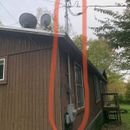Rain Screen: Furring, Entangled Mesh, Sill Seal, or no Rain Screen
Hi all,
Some of you have seen my Pretty Good House and Thermal Bridge questions as I’m working towards finalizing a building envelope design for a remodel in the Catskills, NY.
Tomorrow, the new standing seam roof goes on, and I’ve been scrambling this past week to get sorted whether we’ll try to put exterior insulation on for a thermal break, as it will affect where the roofers place the continuous soffit vents in new soffits.
The builder, who is normally a passive house builder, but in this case, more PGH, suggested it’s too much risk and potential difficulty / cost to do the exterior insulation, with new soffits going in tomorrow and the unknowns. So we’re back to the original assembly, without a thermal break, where we insulate and air seal inward from the 2X6 walls.
For this assembly, the builder recommended no rain screen, because he feels most of the vapor drive will be outward in Climate Zone 6. He’ll be air sealing inside the 2X6 wall with either Intello Plus or Siga Majrex 200, and he feels most of the moisture will not get through this barrier from the outward vapor drive.
Meanwhile, on exterior, there will be board and batten hemlock cladding, which naturally has more gaps than other cladding styles, so I think it will have more ventilation and ability to dry? Fyi, we will be staining it black or charcoal, but not painting it.
Then a fully self-adhered WRB, something like Henry Blueskin VP100, Siga Majvest SA, Pro Clima Adhero or Rothoblaas Transpir. Michael noted these ones, but I think the builder uses same mix.
Then there is the original T1-11 siding on most of the house, before the 2X6s. So far, the plan is to keep the T1-11 and not remove it, and treat it like the sheathing. It’s in decent shape.
I’ve listened to the BS and Beer Episode on Rain Screens, and clearly the average answer is that it’s good to have one, but also, as usual, “it depends”, especially on the materials used in assembly and the climate zone.
My question to the community is whether it seems the assembly described above and attached as PDF should be ok without a rain screen?
I’d personally like to avoid a rain screen, if it seems this could work. Reasons:
* Keeping critters out
* Reduced cost and ease of implementation (see next one)
* This house has electric coming in over ground from across street, though to electric pole that penetrates roof and edge of soffit, down to electric box on wall of house. To make electric go underground would cost a small fortune, so my plan is just to paint the whole thing black, except the readout panel, so it recedes into the dark stained board and batten. We do need to get whatever changes T1-11 factored in by tomorrow or Tuesday, when roofers will cut the hole for in new metal roof for this electric pole. At the moment, we pulled the pole brackets off, shimmed in a 1″ hemlock piece that’s same size as future cladding, and cut into soffit so the pole pulls out that far. See attached photo…yes, I know, it’s ugly. It will get better.
I hope this sheds enough light for some input. From the BS and Beer Podcast, two alternatives I heard, that seem more cost effective and provide at least a small rain screen gap are an entangled mesh (Cedar Breather, etc) or using Sill Seal to make one (still unclear how this works).
Any thoughts from the community? Can this assembly work ok? Needs a tweak? Will vapor drive in winter and summer in Climate Zone 6 be ok? Thanks in advance!
GBA Detail Library
A collection of one thousand construction details organized by climate and house part










Replies